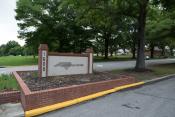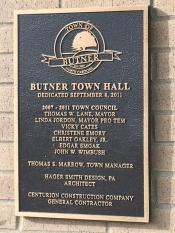Town History

Camp Butner
At the time the United States entered World War II, approximately 40,300 acres of agricultural land within southern Granville County were purchased by the Federal Government. “Camp Butner Reservation” was established on August 4, 1942 and named in honor of the late Major General Henry Wolfe Butner, a native of Surry County who died in 1937 following a distinguished military career. Camp Butner was established for the training of infantry divisions and various artillery and engineer units within the Fourth Services Command, Army Ground Forces. During 1942 to 1945, Camp Butner’s primary mission was to train combat troops for deployment and redeployment to the European and Pacific theaters. The Camp contained rifle ranges, artillery ranges, a prisoner of war compound, barracks, and support services for approximately 40,000 troops.
The War Department officially closed Camp Butner on January 31, 1947. On April 26, the War Assets Administration assumed responsibility for the acreage. As the Camp was phased out, over 20,000 acres were sold back to the farmers who had original ownership and approximately 5,000 acres were transferred to the North Carolina National Guard for training. Over 13,000 acres were transferred to the State of North Carolina. On November 3, the State of North Carolina took over the Camp and assumed the police and fire services.

John Umstead Hospital
During the phasing out of Camp Butner by the State of North Carolina, Mr. John Umstead, brother of Governor William B. Umstead, initiated a move to provide better care for the mentally ill. The abandoned army hospital became the site for John Umstead Hospital. The hospital served 16 counties of the North Central Region and its primary function was to provide an in-patient facility to diagnose and treat individuals with psychiatric disorders, restore them to an optimal level of functioning and return them to the community.

Murdoch Center
Also during 1947, the Butner Training School, known as “The Colony,” opened. The site, an old army barracks, received its first transfers from Caswell Center on June 9, 1948. In 1955, construction began on the current site, which in 1963, became known as the Murdoch Center. The center was named after the late Dr. James Murdoch, who was known for beginning a new era of reform in mental health in North Carolina. Today, the Murdoch Center provides services in a comprehensive residential setting for severely mentally disabled individuals.

Incorporation
1947 was also the year that the State Legislature designated the State Board of Mental Health as the governing body of Butner. The Board was given the power to prepare, adopt and enforce ordinances and regulations for the development of both the State and privately owned property in the area. In 1973, following a reorganization of State government, the Department of Human Resources (currently the Department of Health and Human Services) was given the responsibility. At this time, the Butner Municipal Committee was appointed to advise the Secretary of Human Resources in governing the Town. The responsibility of managing the Town was assigned to the business manager of John Umstead Hospital.
The Department of Health and Human Services employed a full-time Town Manager. The Butner Planning Council, comprised of seven Butner residents, had formal powers in the adoption and administration of land use ordinances and represented an informal advisory role towards other municipal powers and services.
The Butner Incorporation Bill #986 was signed by Governor Mike Easley on July 27, 2007 and the Town of Butner officially incorporated as a municipality on November 1, 2007. The Town operates with a full-time Town Manager and under the Council-Manager form of government prescribed in North Carolina General Statute 160A-147. Elected officials consist of a Mayor, who serves a two (2) year term, and six (6) Council members with four (4) year terms. Butner celebrated its 10th anniversary as an incorporated municipality on November 1, 2017.
